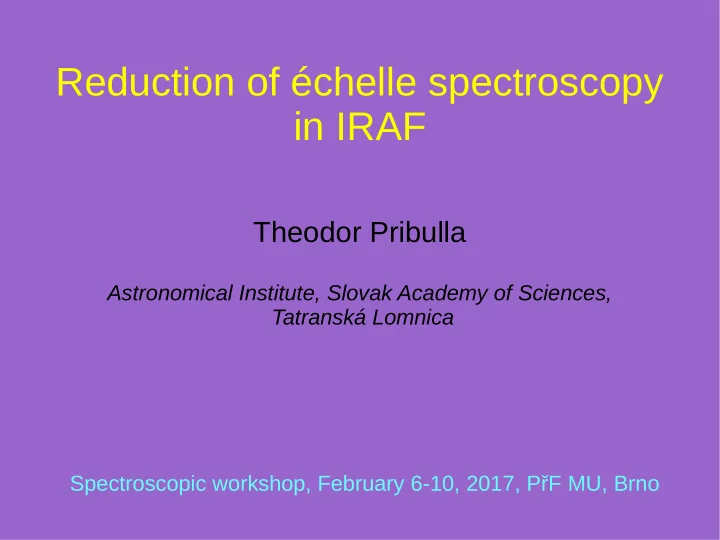

Reduction of échelle spectroscopy in IRAF Theodor Pribulla Astronomical Institute, Slovak Academy of Sciences, Tatranská Lomnica Spectroscopic workshop, February 6-10, 2017, PřF MU, Brno
1. Prerequisites to reduce spectra ● Many alternative ways of echelle spectroscopic reduction exist !!! ● Types of spectra: biases and darks (depends on CCD temperature), object spectra, comparison spectra (e.g. ThAr, FeAr, HeNe), lamp flats (continuous light of tungsten, LED), alternatively chip flats (uniformly illuminated CCD chip without the spectrograph) ● FITS headers should contain: imagetype (flat, dark, object...), object coordinates (RA,DEC), geographical coordinates (longitude, latitude), dispersion axis (DISPAXIS keyword = 1 or 2), gain and read-out noise etc. ● CCD bad pixel mask should be produced with pixels, rows, columns of bad (e.g. hot or insensitive) pixels listed in ASCII file, e.g.
A typical FITS header
2. Photometric reduction ● overscan correction in ccdproc ● making master darks using darkcombine, flatcombine ● photometric reduction of the object frames, below is dark, flat and and bad-pixel correction done (list of parameters created by mkscript) ● removal cosmic hits/spikes (program of V. Pych can be used), alternative is crutil. package in IRAF ● cosmic hits are easily detected and removed when combining multiple spectra
3. Co-adding the frames ● For long-period objects it is practical to co-add the frames to (i) boost SNR (ii) clean cosmic hits ● It is good to define statistical region to weight the frames according to the signal, this can be done by first tracing lamp flats
4. Finding the echelle orders ● Now we work in noao.imred.echelle and use task apfind using a spectrum of well-exposed lamp flat or early-type star
5. Defining the apertures and bckgrnd ● Still working in apfind edit the apertures ● Ordering, resizing, deleting, adding of the apertures (=echelle orders) ● Important keys are: . (dot) - selects nearest aperture, l and u - lower and upper range for the aperture, b - set the background, t - initialize, s+s - background range, f - fit the background
6. Tracing the apertures ● still working with the lamp flat or early-type stellar spectrum use aptrace ● for first order-definition work interactively ! ● important keys are: f - fit, d -delete a point, a - add a point, with colon commands one can change e.g. order, polynomial type, number of iterations ● fitted traces are stored in database/ directory and can be used as a reference for future reductions ● when in a script the typical settings look like:
7. Extracting aperture spectra ● Spectra are extracted for object and comparison lamp spectra (ThAr, FeNe...) ● Aperture reference from the traced spectrum is used, apertures are NOT edited or traced now ● In scripts more parameters can be used to control e.g. background subtraction, type of the extracted spectrum 2D or 3D (so called extras)
7. Identifying comparison lines ● Well exposed arc/hollow cathod lamp spectrum is needed, e.g. ThAr, FeNe, FeAr. ● The line lists and plots can be found at KPNO, e.g. https://www.noao.edu/kpno/tharatlas/thar/thar.html ● N.B. depending on the calibration source current the lines of different ionization/excitation will change their relative intensity !!! ● ecidentify task is used: ● Important key commands: marking a line is done by m + typing catalogue wavelength, to produce a fit press f, orders are changed with j and k ● It is advisable to identify at least 5 lines every other aperture ● after the fit is obtained the x scale changes from pixels to Å ● catalogue wavelength is then suggested after pressing m ● prior to running the command it is practical to set at least the type and order degree of the fitting polynomial in both axes, 4 is appropriate typically
8. Line re-identification ● Automated re-identification of the features and solution of all comparison spectra for a given night:
9. References and wavelength sol. ● Assigning the reference comparison spectra for the object spectra. ● Typically the spectra are assigned according to JD. It is ideal to have comparison spectra just before and just after each object spectrum ● Dispersion correction of the spectra (using comparisons as references):
10. 2D to 1D and rectification ● First, individual orders are rectified to using continuum task and the fits are saved as 2D ● Then 2D fits to the continuum and 2D spectra are combined to 1D spectra using scombine task: ● Finally, 1D object spectra are divided by 1D continuum fits resulting in 1D combined and rectified object spectra using sarith task
11. Spectrophotometric calibration Calibration to fluxes, e.g. erg/s/m 2 /Å using spectrophotometric standards ● Complicated by (i) fiber opening/slit loses, (ii) chromatic atm. refraction (for low X), ● (iii) atmospheric extinction, k = k(λ) (iv) blaze function (v) order overlap
11.Spectrophotometric calibration ● The principal steps are: -adding standard star to the sensitivity file using stand task (for a selected spectrophotometric standard) -computing sensitivity and extinction function using sensfunc -calibrating continuum of the selected standard using calibrate -dividing spectrum of the object by the continuum fit of the standard and multiplying the result by the standard calibrating spectrum ● correcting the result for the different exposure times using sarith
12. Heliocentric and barycentric RVs ● Geocentric wavelength system of the spectrum is transformed to barycentric/heliocentric system using bcvcorr task ● Heliocentric Julian date is computed by setjd task: ● Wavelength system of a spectrum is then Doppler corrected:
Recommend
More recommend